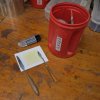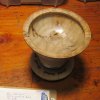putting a Starbond order together
I am trying to put a Starbond order together. I think I want the EM-40, described as runs like water, for general thin CA use and to try to reinforce damaged blanks. There is one thinner standard CA Starbond offers but I have issues with the CA soaking into the wood more than desired even when I wipe a little BLO on the surface to try to prevent surface staining. When I turn away the surface I often find a discolored area about an eighth inch wide both sides of the crack.
The other use I want a CA glue for is attaching glue blocks when I don't want to wait on Titebond II to dry. Here I have two options, EM-600 described as syrupy and will fill an .008" gap. They also offer the KEG five hundred in a very similar consistency and gap filling ability according to the literature. It is listed as four times stronger, and flexible. The brag on it is shock absorbance, seems made to order for a glue block if it can be removed by any manner short of turning the block away. Even that wouldn't be that big of a deal.
I saw a title of a thread somewhere asking about the KEG glue but haven't been successful searching to find old threads. I don't know which site I saw that on but have tried searching three or four.
Thoughts on which higher viscosity glue to use? Which of these or neither, get something else. Same on the thin glue. I don't think I want the very thinnest stuff. It is for use with a .002 gap compared to a .004 gap fill with the slightly thicker stuff I am considering buying so there doesn't seem to be a vast difference. There is a four times stronger version of the super thin stuff too but I am concerned with controlling the application of the super thin glue, I mostly glue fingers and other annoying things together with very thin CA and don't have much success gluing anything that isn't a 100% perfect fit.
Thanks for your assistance! Hopefully a pretty simple thread this time.
Hu
I am trying to put a Starbond order together. I think I want the EM-40, described as runs like water, for general thin CA use and to try to reinforce damaged blanks. There is one thinner standard CA Starbond offers but I have issues with the CA soaking into the wood more than desired even when I wipe a little BLO on the surface to try to prevent surface staining. When I turn away the surface I often find a discolored area about an eighth inch wide both sides of the crack.
The other use I want a CA glue for is attaching glue blocks when I don't want to wait on Titebond II to dry. Here I have two options, EM-600 described as syrupy and will fill an .008" gap. They also offer the KEG five hundred in a very similar consistency and gap filling ability according to the literature. It is listed as four times stronger, and flexible. The brag on it is shock absorbance, seems made to order for a glue block if it can be removed by any manner short of turning the block away. Even that wouldn't be that big of a deal.
I saw a title of a thread somewhere asking about the KEG glue but haven't been successful searching to find old threads. I don't know which site I saw that on but have tried searching three or four.
Thoughts on which higher viscosity glue to use? Which of these or neither, get something else. Same on the thin glue. I don't think I want the very thinnest stuff. It is for use with a .002 gap compared to a .004 gap fill with the slightly thicker stuff I am considering buying so there doesn't seem to be a vast difference. There is a four times stronger version of the super thin stuff too but I am concerned with controlling the application of the super thin glue, I mostly glue fingers and other annoying things together with very thin CA and don't have much success gluing anything that isn't a 100% perfect fit.
Thanks for your assistance! Hopefully a pretty simple thread this time.
Hu
Last edited:


